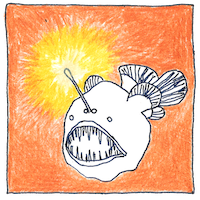George and Elizabeth Peckham
evolution

|
Aggressive mimicry
As opposed to defensive mimicry for which the mimic avoids harm by appearing harmful, aggressive mimicry harms others by appearing harmless. Elizabeth Peckham called defensive mimicry “direction protection” and she wrote that cases of “indirection protection” included spiders that mimic unpalatable creatures some for protection, some for capturing prey, and some for both. George and Elizabeth studied defenseless spiders of the family attidae that mimic ants, which helps them escape from birds that eat spiders.
Wolf in sheep’s clothing
There are many cases of agressive mimicry. the wolf in sheep’s clothing intentionally deceives the sheep but accidentally deceives the shepherd who butchers the sheep for meat. The northern shrike mimics the songs of small birds to lure them to their death. The tongue of an alligator snapping turtle has a worm-like extension that lures fishes that it eats. The assassin bug eats spiders and plugs the silk of the spiders’ webs to mimic a bug caught in it. Bolas spiders lure male moth flies by mimicing the female moth flies’ sex pheromones. The sabre-toothed blenny mimics the dance of the bluestreak cleaner wrasse but instead of cleaning the grouper takes a bite of its fin. Parasitic larva of the shellfish Lampsilis are injected into a fish by the female shellfish who lures the fish using extensions that mimic tiny fish. The haplochromine cichlid plays dead, lying on its side on the lake bottom and faking a blotchy skin, but eats any scavenger that approaches.
Instances
“In looking for instances of protective form and color among spiders we encounter one difficulty at the outset. The meaning of a protective peculiarity can be determined only when the animal is seen in its natural home. The number of strangely modified forms depicted in descriptive works on spiders is enormous. Bodies are twisted, elongated, inflated, flattened, truncated, covered with tubercles or spines, enclosed within chitinous plates, colored like bark, like lichens, like flowers of every imaginable hue, like bird droppings, like sand or stones, and in every one of these modifications there is doubtless an adaptation of the spider to its surroundings which when it is studied out of its natural relations, we can only guess at.” —E.G.P. Strangely modified forms are doubtless adaptions we can only guess at.



Cases of predatory human behaviors are technically not aggressive mimicry unless you assume that the con artists (Nigerian princes, car salesmen, insurance agents, politicians) do not deceive their victims intentionally.
See also in The book of science:
Readings in wikipedia:
Other readings: